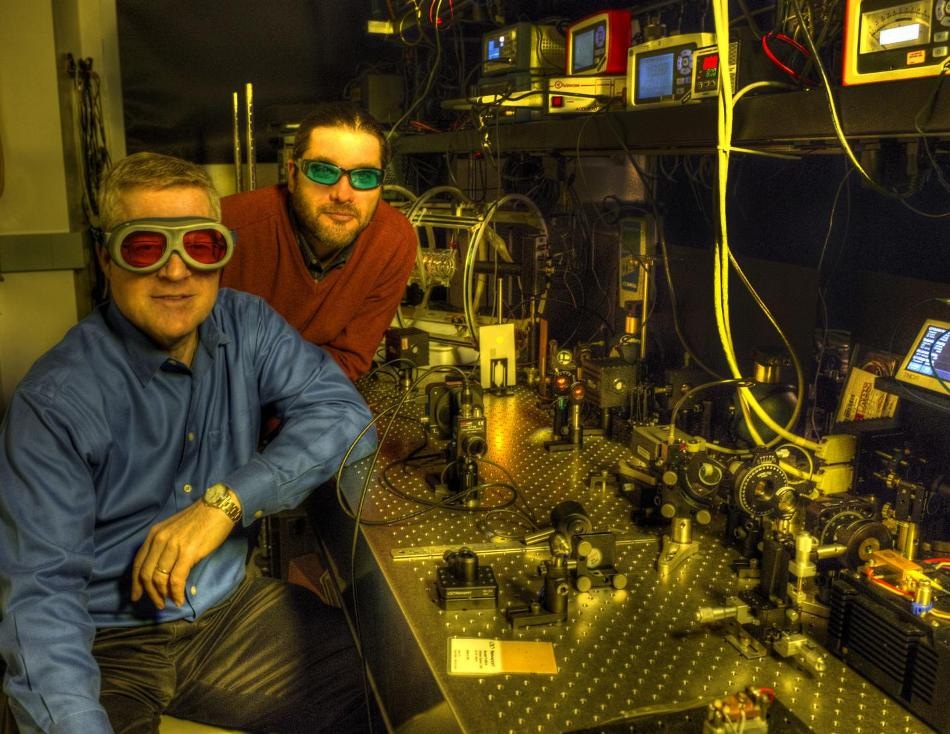May 17 2017
 Mike Krainak (left) and Diego Janches recently won NASA follow-on funding to advance a spaceborne sodium lidar needed to probe Earth’s poorly understood mesosphere. Credits: NASA/W. Hrybyk
Mike Krainak (left) and Diego Janches recently won NASA follow-on funding to advance a spaceborne sodium lidar needed to probe Earth’s poorly understood mesosphere. Credits: NASA/W. Hrybyk
Engineers and scientists from NASA now believe that they can leverage latest improvements in a greenhouse-detecting instrument to construct the world’s first space-based sodium lidar in order to study the poorly understood mesosphere of the Earth.
Scientist Diego Janches and laser experts Mike Krainak and Tony Yu, all working at NASA’s Goddard Space Flight Center in Greenbelt, Maryland, are together heading a research-and-development effort that aims at bringing about further improvements in the sodium lidar, which the team plans to plans to deploy on the International Space Station if it succeeds in establishing its flightworthiness
Funds for the instrument’s maturation are currently provided by NASA’s Center Innovation Fund and the Heliophysics Technology and Instrument Development for Science programs. However, the very heritage of the concept is partially traced back to NASA’s past investments in promising Sounders—lidar instruments originally developed to measure methane and carbon dioxide in Earth’s atmosphere.
The instrument, from its berth on the orbiting outpost, will illuminate the complex relationship between the dynamics and chemistry of the mesosphere that exists 40-100 miles above Earth’s surface —the area where the vacuum of space is met by the Earth’s atmosphere.
The researchers are optimistic about the eventual success of the instrument based on the progress made by them with the Earth-observing sounding instruments, coupled with Goddard’s legacy in laser technology.
The Big Leverage
What we’re doing is leveraging what we learned with the CO2 and Methane Sounders.
Mike Krainak, NASA
In a number of aircraft campaigns, both instruments have demonstrated that they accurately measure greenhouse gases using lidar.
Lidar is responsible for pulsing a laser light off Earth’s surface. Methane and carbon dioxide, like all atmospheric gases, absorb the light in narrow wavelength bands. Scientists tune the laser across those absorption lines in order to detect and then examine the level of gases in that vertical path. Deeper absorption lines are obtained when increased gas volumes are present along the light’s path.
The same principle applies here. Instead of carbon dioxide and methane, we’re detecting sodium because of what it can tell us about the small-scale dynamics occurring in the mesosphere.
Diego Janches, Scientist, NASA
A useful tracer for characterizing the mesosphere is sodium, which is the sixth most abundant element in Earth’s crust. Though this atmospheric layer comprises of other granules of metals, including potassium, calcium, magnesium, and iron— all developed by the evaporation of extraterrestrial dust when it enters the Earth’s atmosphere — sodium is considered to be easiest to detect. A layer of sodium literally exists in the mesosphere.
Sodium provides higher-resolution data due to its relative abundance, and this data can reveal additional details about the small-scale dynamics taking place in the upper atmosphere. This will indeed enable scientists to learn a lot about how weather in the lower atmosphere influences the border present between space and the atmosphere.
The researches have started to develop their instrument, which is electronically tuned to the 589-nanometer range, or yellow light. While in orbit, the lidar is capable of rapidly pulsing the light at the mesospheric layer, down one to three kilometers over a swath whose width measures four to eight kilometers.
The interaction of the light with sodium particles allows them to resonate or glow. By identifying the glow-back, the lidar’s onboard spectrometer will be able to examine the light in order to determine its temperature, the quantity of sodium that resided in the mesosphere, and the speed at which the particles were moving.
Sodium lidars were used by scientists in ground-based measurements for almost four decades, but they were never able to gather measurements from space. This led to data being limited in space and time and the data does not even offer a global picture of the dynamics. However, with the help of a custom designed spaceborne sodium lidar, scientists will be able to illuminate particular areas, exposing the small dynamics that presently are biggest unknown, according to Janches.
The researchers will use the funding from NASA to enhance the technology that locks the lidar onto the sodium lines. “It’s like a guitar string,” Krainak explained. “If you want a certain tone, you need to lock down the string at a particular length. It’s the same thing with the laser cavity length.”
The researchers also aim at demonstrating an environmentally tested engineering test unit of the laser, thus enhancing its technology-readiness level to six, which highlights that the technology is all set for flight development.
“We’ve made significant progress on the laser. If we win, we could be the first space-based sodium laser spectrometer for remote sensing.
Mike Krainak, NASA